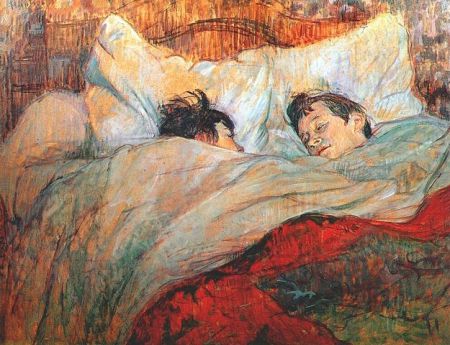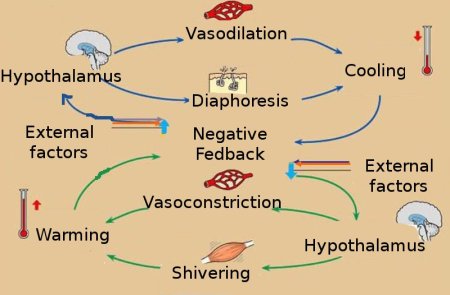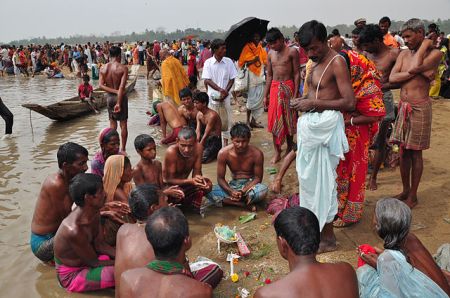Post 618 –by Gautam Shah
.
A climate affects our body system very profoundly. The effects are warmth-cold, pressure and moisture, all sensed by the skin. Five types of sensations are involved with the skin such as, Touch-Pressure (mechanic-o receptors), Cold-Warmth feeling (thermo receptors), Pain and Itch. Cold is a consequence of contraction of blood vessels, and warmth is felt due to dilation of blood vessels, both felt by the same receptors.

Cold Comforter > Wikipedia image ART by Henri de Toulouse-Lautrec (1864-1901)
Our body functions as a thermal equilibrium system. The thermal bearing capacity has upper and lower limits. The pain occurs at the upper limit of 52°C /126°F, and has a lower limit of 3°C/37°F. The optimum or the comfort level temperature depends on the level of acclimatization. In certain acute work conditions like mines, metal smelting plants, textile plants, cold storage, the efficiency or productivity depends on the endurance level and adaptability of the body. A body may endure or adopt to certain abnormal conditions for a period of time, but there may be side effects. The side effects may be realized in a different form and at a different time.

Day time sleepers > Image on Wikipedia by Julio Rojas + Flickr as Day_Sleepers
Our body, gains heat from the atmosphere, and also dissipates excess heat to it, to maintain thermal equilibrium. The human body maintains itself at an average temperature of 98.4°F / 37°C. There are many minor variations in body temperature, which are considered normal. Body temperature is highest in the evening and lowest in the morning, within a range of 1.5°F / 1°C. Infants have a very imperfect mechanism for regulation of body temperature. A fit of crying may elevate and a cold wash may lower the body temperature. Aged persons have a low metabolism and so maintain a lower body temperature. It takes much longer for an aged person to gain or dissipate body heat. Female body temperature is slightly lower than male.

Homeostasis temperature regulation > Wikipedia image
The type of food one takes affect the body temperature. High protein foods increase the body temperature. The act of ingestion and food digestion raise the body temperature. Exercise increases the body temperature, because only 25% of muscular energy is converted into mechanical work, rest comes out as body heat. Atmospheric conditions like, atmospheric temperature, humidity and movement of air, affect the efficiency of heat exchange from the body, and so the body temperature.
There are THREE types of heat generating processes in the human body. Conversion of food matter into useful energy is a continuous heat generating process. Muscular activities, like even sedentary work or sleeping, are heat generating processes. Lastly, certain infections and dysfunctions within the body, elevate or lower the body temperature by extra ordinary rate of heat generation, or weakened heat dissipation mechanisms. Of all the energy produced in the body only 20% is utilized, rest 80% is surplus heat.

Hindu bathing ceremony > Wikipedia image by Balaram Mahalder
Normal skin temperature is between 31° and 34°C. As the air temperature approaches the skin temperature heat loss from the body gradually decreases, vasomotor regulation will increase the body temperature to 34°C to maintain the heat loss, but if air temperature is higher, the convective heat loss may not work.
As long as temperature of the opposite surface or object (sun, fire, radiator) is below skin temperature, the body can lose heat by radiation. But once it reaches the equilibrium occurs, body will rather gain heat by radiation.

Hot arid climate Cooking > Wikipedia image by User: (WT-shared) Shivya at wts wikivoyage
When the convective process is inoperative and radiation heat gain is positive, the body can maintain the thermal balance by evaporation. Evaporation can occur if air has velocity and appropriate humidity (low). Even in case of very high humidity conditions a high velocity air can remove the humidity.
A person exposed to a constant high rate of sweating and permanent vaso-dilation can have a lot of physical strain with loss of work efficiency.
The body must not only release all the excess heat that is generated from within the body, but all the excess heat as gained from the environment. Heat is lost from the body by radiation (60%), evaporation (25%), by convection and conduction (15%).

Beach Hammock > Wikipedia image > Photo taken by flickr user ReubenInStt
Heat is lost through radiation, if there is a difference in temperatures of opposing surfaces. Evaporation heat loss is controlled by the level of humidity in the air (dryer the air, faster the evaporation), temperature of the air, body and rate of air movement. Body dissipates heat through evaporation by perspiration, sweat and exhalation of air. Convection occurs when the air in the vicinity of skin becomes hot, expands, decreases in density, and elevates to allow cooler air in its place. Rate of heat convection from body depends on the difference in temperatures (skin & surrounding air) and rate of air movement. Conduction depends on the difference between the body temperature and the contact object.

Working in very Hot conditions > Wikipedia image ART by Peder Severin Kroyer (1851-1909) from Fra Burnmeister og Wain’s Iron foundry
The body continues to accelerate or decelerate the heat loss till it reaches equilibrium. Heat loss is accelerated by several body functions like perspiration, high transfer of heat to the skin by increased blood circulation (vaso-dilatation). When these prove to be insufficient, sweating occurs. In hot climates the heat loss rate is lower due to unfavourable atmospheric conditions. But by lowering of the body heat generation (lower metabolic and muscular activity), the net amount of heat to be dissipated can be reduced. But this requires some time to take effect. On immediate basis when the heat loss is not balanced with heat gain, the `heat stroke’ occurs. In cold climates the heat loss is higher, so heat balance is achieved by conservation of heat and by appropriate heat gain. Heat production is raised by certain reflex secretions (adrenaline, thyroxine), higher intakes of food (increased metabolic activity) by reflex shivering (muscular exercise) and by sufficient insulative protection. The body may control the heat loss by vaso-constriction (lower blood supply), and depressed sweating.
Many physical, chemical and bacterial agents disturb the heat regulation mechanism and cause fever. These may be due to increased heat production or reduced heat loss, or both.

Cold-Blood creatures or Reptiles > Wikipedia image Attribution: Postdlf from w
In a reptiles and amphibia heat regulation mechanism is absent. Their body temperature rises or falls with the atmospheric temperature. Hence they are called cold blood animals. In abnormal temperature conditions they regulate the body temperature by suitable habitat. In winter they go deep into burrows or in hibernation (minimize the metabolic heat generation). Mammals and birds are known as hot blood creatures, because the heat regulation mechanism is well developed, and they are able to maintain a level of body temperature.

Hot blood animals > Wikipedia image derivative work: Mariomassone
Comfort of an occupant in an environment also depends on subjective variables or individual factors:
1 Acclimatization: exposed to new conditions a person shortly (approx. 30 days) acclimatizes own-self.
2 Age and sex of a person: Older persons take much longer to adjust to temperature change, and as a result slightly higher temperature. Women also have slower metabolic rate than men so prefer a little higher temperature.
3 States of health: Activity / heat output in watts
- Sleeping 70
- Sitting, typing 130/160
- Standing, working at a bench 160/190
- Walking 220/290
- Digging 440/580
- Sustained hard work 580/700
.
Pingback: LINKS to my BLOGS on CLIMATE | Interior Design Assist